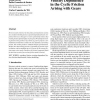Free Online Productivity Tools
i2Speak
i2Symbol
i2OCR
iTex2Img
iWeb2Print
iWeb2Shot
i2Type
iPdf2Split
iPdf2Merge
i2Bopomofo
i2Arabic
i2Style
i2Image
i2PDF
iLatex2Rtf
Sci2ools
IJRR
2002
2002
Velocity Dependence in the Cyclic Friction Arising with Gears
Recent research on friction in robot joints and transmission systems has considered meshing friction a position-dependent friction component. However, in this paper we show experimental evidence that meshing friction depends highly on joint speed. We identify the meshing friction in the gearboxes of a robotic leg, and we propose a new mathematical model that considers the rate dependency of meshing friction. The resulting model is validated through experimentation. Results show that meshing friction is responsible for friction torque oscillations with an amplitude up to 25 percent of the average friction torque at low speeds. Therefore, this friction component should be taken into account if an accurate friction model is desired. KEY WORDS--meshing friction, position-dependent friction, friction identification, friction modelling
| Added | 22 Dec 2010 |
| Updated | 22 Dec 2010 |
| Type | Journal |
| Year | 2002 |
| Where | IJRR |
| Authors | Elena Garcia, Pablo González de Santos, Carlos Canudas de Wit |
Comments (0)

